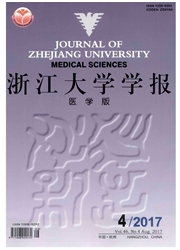

 中文摘要:
中文摘要:
目的:以锌卟啉为识别基团,制备一种锌卟啉化聚酰亚胺电纺纤维膜,用于微量氨气的检测。方法:通过化学共聚将锌卟啉引入聚酰亚胺大分子主链;采用静电纺丝技术制备锌卟啉化聚酰亚胺电纺纤维膜,通过记录其作用前后膜的颜色及光谱变化实现对氨气的检测,并考察其灵敏度、选择性及检测限。结果:制备的锌卟啉化聚酰亚胺电纺纤维膜中卟啉单元分布均匀,保持了锌卟啉的基本光谱特性。与氨气作用时,电纺纤维膜发生明显颜色变化和紫外光谱红移。表面等离子共振及紫外光谱计算得到锌卟啉化聚酰亚胺电纺纤维膜与氨的结合常数Ka为3.33×103L/mol,检测限为3.13 mg/m3。结论:本研究制备的锌卟啉化聚酰亚胺电纺纤维膜对氨气有良好的灵敏度和选择性,可重复使用,是一种检测微量氨气的新材料。
 英文摘要:
英文摘要:
Objective: To prepare a zinc porphyrinated polyimide nanofibrous membrane for rapid detection of trace amount of ammonia. Methods: Zinc porphyrin chromophore was copolymerized into polyimide backbones and the according nanofibrous membrane was prepared by electrospinning technique. Ammonia detection was achieved by recording the color and spectral changes of the membrane before and after exposing to the target gas. The sensitivity, selectivity and detection limit of prepared membrane were further studied. Results: The obtained nanofibrous membrane preserved typical photophysical properties of zinc porphyrin chromophores. When exposed to ammonia, a dual chromo- and spectrum responses of the nanofibrous membrane were observed. The binding affinity constant and the detection limit of zinc porphyrinated polyimide nanofibrous membrane calculated from surface plasmon resonance ( SPR ) analysis Conclusion: The membrane towards ammonia detection. and UV-vis were 3. prepared in this study 33 × 10^3 L/mol and 3. 13 mg/m3, respectively. exhibits good sensitivity, selectivity and reproducibility
 同期刊论文项目
同期刊论文项目
 同项目期刊论文
同项目期刊论文
 期刊信息
期刊信息
